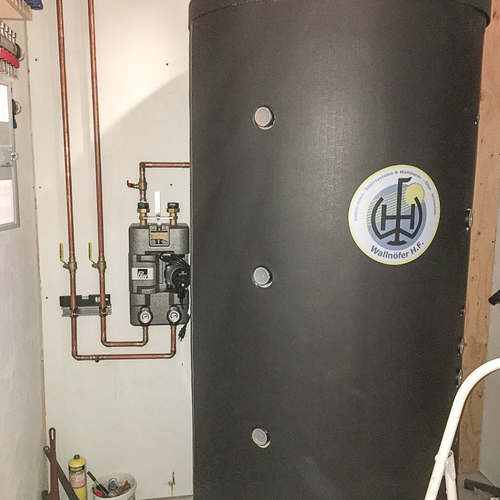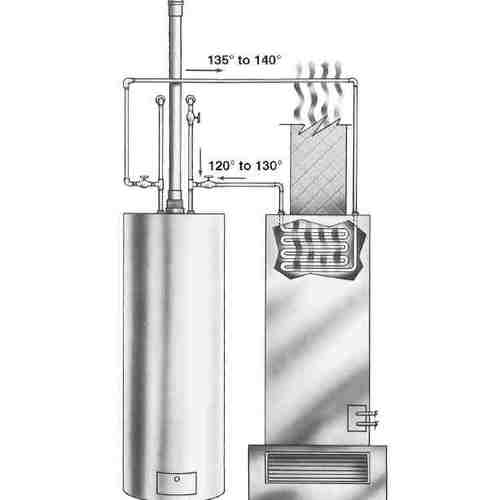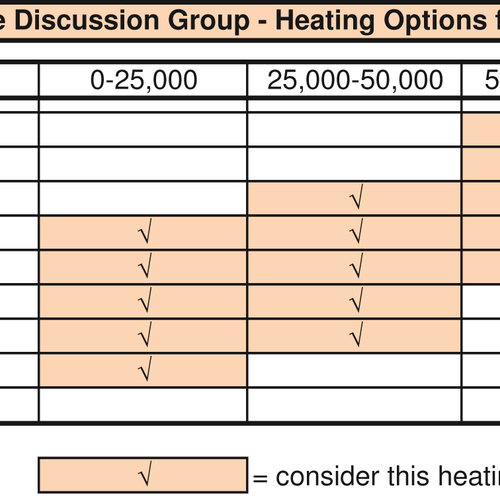Image Credit: Energy Vanguard
Professor John Straube spoke for a whole day at the Building Science Corporation’s Experts’ Session earlier this month. His topic, a good one for GBA readers, was mechanical systems for low-load buildings.
You know that expression about how the information comes at you so fast in some classes that it’s like drinking from a firehose? With Professor Straube, it’s like trying to drink from a tsunami! The guy has not only a phenomenal knowledge but he’s also a fantastic teacher and incredibly witty.
Giving you a good overview of everything Straube talked about would be quite a challenge (and result in an article longer than anything Martin Holladay has written here!), because he really covered the whole gamut of this topic. So, I’ll throw out a few highlights of the day here and encourage you to attend one of his workshops if you ever get the chance.
You may also get the opportunity some day to buy his book on this topic. As we were talking on the last night, Joe Lstiburek and others strongly encouraged Straube to get this knowledge into a book, and I hope he does.
It’s hard to find a furnace rated at less than 40,000 Btu/h
Building enclosures have improved dramatically in the past two decades. We have more insulation, better windows, and sealed air barriers. Many homes have peak heating loads of 15 to 30 thousand BTU per hour (kBTU/hr) — even in cold climates. This applies to large houses and buildings, too, because high performance enclosures result in zones with low loads. The problem is that most conventional heating equipment available doesn’t go that low in capacity. About the smallest furnace you can get is 40 kBTU/hr.
Professor Straube mentioned that he’s been talking with HVAC equipment manufacturers about this for about a decade, and they just don’t get it. Carrier and Trane, he said, have told him they don’t sell low capacity equipment because no one’s buying it. They failed to see that if the equipment is not available, no one can buy it so of course they’re not buying it because it’s not available. Evidently those discussions haven’t turned the corner yet.
Specifying low-capacity equipment won’t save you any money
Straube covered a lot of ground in his presentation. After introducing the need for low-capacity mechanical systems and the lack of conventional equipment, he dove into the details of the different systems available, how they work, what some of the limitations are, and how difficult it is to do it right.
One of the big obstacles is cost. “We’re beyond talking about saving money on equipment for low-load houses,” he said, because you won’t. If you’re a spray foam contractor, for example, trying to get builders to bite on the higher cost of foam because of savings they’ll see from smaller mechanical systems, it’s not gonna happen.
You can get a 46 kBTU/hr 95 AFUE furnace for $697. If you want something with less capacity, you could go for a boiler, tankless water heater, or minisplit heat pump, all of which are significantly higher in cost.
The same is true of air conditioners. When you go from a 2-ton system to a 1.5-ton system, it costs more and is less efficient, too. So if you want a low-load building to have a low-capacity mechanical system, get used to higher cost.
Returning water temperature affects efficiency
In the first half of the day, Straube went through some of the basics of efficiency ratings (SEER, EER, and COP), details about condensing boilers and furnaces, and combo systems (using one system to provide heat and domestic hot water). He talked about some of the problems with condensing systems and the temperature of the entering water or air.
If you think you have a boiler that’s 95% efficient, for example, you may not be getting that if the water returning in the hydronic distribution system comes back too warm. Condensing boilers and furnaces work by extracting the latent heat from the water vapor in the exhaust gases. They’re able to do so as long as the heat exchanger is below the dew point. If the returning water (or air in an air distribution system) is above the dew point, the water vapor doesn’t condense, the boiler/furnace doesn’t extract as much heat, and the efficiency goes down. The graph of condensation efficiency shows how the efficiency changes with returning water temperature.
Desuperheaters? Thumbs down
After lunch, the discussion turned to heat pumps, both conventional, ground source, and minisplits. He blasted the idea of using desuperheaters on ground-source heat pumps to get hot water because they’re usually not cost-effective and don’t give you much hot water. Ground-source heat pumps work well in school-sized buildings, he said, but not so well for low-load buildings or really big buildings. He also said that he has not seen any third party data on GSHP efficiency showing a COP higher than about 3. Since the industry doesn’t include pump or blower energy in their COP calculations, Straube said, their COP numbers are higher but don’t give the complete picture.
The topic was mechanical systems, so there was also talk about water heating. Combo systems give you both heat and hot water, and some people use water heaters just for space heating, too. Straube mentioned that HVAC and DHW need to come together.
Looking back over my notes now, I still can’t believe how much material he covered. It really was a tsunami of information. He also spoke briefly about using CO2 as a refrigerant in air-to-water heat pumps, which allows true hot water production because they can get higher temperatures than the standard refrigerants; electric resistance heat, which is OK in some cases for low-load buildings; Legionnaire’s disease, which can be a problem if the DHW temperature is too low; heat pump water heaters; distribution of thermal energy (air, water, radiant); and more.
The wit of Professor Straube
As I mentioned at the beginning, Professor Straube is not only incredibly knowledgeable, he’s also a walking quote machine. Here are a few of the many witticisms we were treated to yesterday:
Caveat emptor is Latin for “you’re gonna get screwed.”
Cats are IAQ problems and you’d have to pass them through the HRV to solve that problem. But they’re not really a cat anymore after that.
Recirculating range hoods don’t solve the IAQ problem. It’s like a recirculating toilet. The stuff just goes round and round and never leaves.
In San Francisco, it never gets really hot or really cold. Buildings are there mainly to keep people away from your stuff.
It’s taken America 10 years to realize that tankless water heaters work better with tanks.
If you ever get a chance to go to one of his talks, I guarantee you won’t have any trouble staying awake and engaged.
A great reason to be a GBA Pro!
Not everyone can take the time to go off to New England for two days to attend a session like this. The good news is that many people watched the whole thing from their home or office because Green Building Advisor ran a livecast of the sessions.
Anyone could have signed up through Building Science Corporation for the regular fee of $395 per day. GBA Pro members, however, got access to the livecast as part of their membership. What a deal! GBA Pro members will also get to watch some of the recorded videos from the Building Science Experts’ Session once they’re posted. Stay tuned!
Allison Bailes of Decatur, Georgia, is a speaker, writer, energy consultant, RESNET-certified trainer, and the author of the Energy Vanguard Blog. You can follow him on Twitter at @EnergyVanguard.
Weekly Newsletter
Get building science and energy efficiency advice, plus special offers, in your inbox.















8 Comments
I enjoyed both Joe and John via GBA
I had planned to attend via a livecast at our local power utility, JEA, but a sick kid kept me home, so a GBA Pro membership seems a bargain.
At any rate, my sole gripe is that most of the information is focused upon heating-dominated climates. I guess that is a natural offshoot of the facts that GBA / Taunton is a New England company and the good doctors both hail from Oh Canada.
That leads to blanket statements such as "Desuperheaters don't work" without regard to important regional differences. Specifically, it is not uncommon to operate cooling for 8-9 months per year in Florida, and that means desuperheaters can and do provide a majority of a home's hot water energy at a fraction of the cost of solar thermal.
We apply them to both ground and air source heat pumps, and they do quite well, but only if they have their own unfired storage tank to slowly accumulate recovered heat.
Smallest gas boilers and heat pump COPs
Amazing.
Here a list of a few dozens of small natural gas(methane)boilers starting at 1.2 kW (ca.4.1 kBTU) from a German plumbing forum:
http://www.haustechnikdialog.de/forum/t/136139/Liste-Gasbrennwertgeraete-mit-kleiner-Leistung-Stand-Okt-2011
The official list of sometimes subsidised natural gas boilers in Germany , starting at 1.7 kW ( ca. 5.6 kBTU)
here:
http://www.proklima-hannover.de/downloads/Produkte/Produkt_Brennwertkesselliste.pdf
Mind the differing flow and return temperatures, important for the min.-max. output.
All listed gas boilers on both lists are condensing gas boilers, some are combi boilers, some are suitable for LPG (LPG/propane operation starts at a higher minimum output).
Shop around, many of the listed manufacturers have outlets(even factories) in the USA as well.
Most boilers are available via web-shops as well , use the search engine.
About heat pumps COPs:
The NTB in Buchs is an independant institute, they have hardly any HPs listed with an COP below 3. Some show a COP of 6 or more.
Anyhow not the COP is important but the seasonal(anual) performance. A fluctuating thermal demand with a fluctuating thermal source has to be seen in combination and compared to give a compareable average value.....
All tests are done in ISO certified labs and according to international test standards:
http://institute.ntb.ch/ies/competences/heat-pump-test-center-wpz.html?L=1
There are many more test labs and -lists out there.
European heating equipment IS smaller...
Heat loads have traditionally been lower in Europe than in the US (due to smaller, tighter dwellings, combined with a milder climate), so the marketing sweet-spot in Europe is at a lower output rating than in the US. Bigger, draftier, houses and colder outside design temperatures drive the US market. While better codes are fixing some of the heat load issues, the trend for ever larger houses continues to offset those gains.
There are a few US importers of lower-output boilers, but not hot-air furnaces (which are relatively rare in Europe.) Hot air furnace heating is less comfortable than hydronic heat, and hot-air distribution is more power hungry and suffers more distribution losses than hydronic systems, but unlike European homes, most US homes need air conditioning, and dual-use ducts is a way to reap cost savings on mechanical systems. (In many colder parts of the US hydronic heating is still more common than hot air, but for newer housing the trend has been moving toward hot air for decades.)
A common solution for low heating load systems in the US has been to adapt condensing tank type hot water heaters for low-temp radiators or coils in air handlers. It works- the buffering mass of the tank avoids short-cycling losses, but every system is a custom design, and not every design out there is a good one. (Examples of over-pumped electricity-wasting versions abound.)
While it's possible to hit north of a seasonal average COP of 5 with hydronic ground source heat pumps, the typical "as designed and installed" system in the US is still well under 4, in part due to air handler power of the ducted tepid-air delivery systems, but also due to the expense of very low temperature hydronic systems (not every house is suitable for using concrete slabs as radiation.) Here again, every system is a full-custom design, and the performance relies heavily on the competence of the designer (seems there's a lot of schooling left to be done.) But with power as CHEAP as it is in the US, it's hard to make the financial case for even going with the expense of ground source heat pumps in heating dominated climates, let alone the design expertise and low-temp heat distribution required to take the last watt out of the system.
Now that ductless air-source heat pumps can hit north of 3 for a seasonal COP for a fraction of the up-front cost, the subsidies available for ground source heat pumps in single-family residences seem mis-placed- putting the money into a higher performance building with mini-split sized loads is often the wiser expenditure. But with bigger houses and many doored-off rooms mini-splits won't always cut it until you're at super-insulation levels- it's a balancing act.
CO2 refrigerant air source heat pump systems have been out there for awhile, but not in N.America. While they CAN operate at higher domestic hot water temperatures, they run at lower efficiency than R410A system when the outdoor temps are cold. But they still have output capacity (if not efficiency) at cooler temperatures than most R410A system. Sanyo has a decent 9kw (30KBTU/hr) and 4.5kw (15KBTU/hr) hydronic output CO2-refrigerant systems that have been marketed in Europe & Japan for several years now. The bigger unit would cover the needs of many existing US homes (not just ultra low-load houses), but while it's more efficient than R410A systems at making domestic hot water, it's well behind the state of the art of ductless R410A mini-splits on space heating efficiency. The fact that it's a 2-stage non-modulating (and noisier) on/off compressor leaves it at a disadvantage under part load relative to the scroll-compressor based R410A systems.
While it's sometimes useful to have HVAC and hot water all coming from the same system, there's nothing inherently more efficient (or lower cost) about it, given the disparate temperature requirements.
Hopefully the US HVAC vendors will clue into the fact that code-min houses (even big 'uns) built to IRC 2012 standards have smaller heating/cooling loads than the average US house of the past. Oversized equipment comes with a comfort penalty, if not necessarily a cost (or even efficiency) penalty.
As a geo installer
...I have to agree that the subsidies are arguably misplaced. It would certainly make sense to apply similar support to weatherization.
Subsidies are blunt instruments (response to curt kinder)
Most geo installers will take a stab a the lowest-possible hanging fruit for weatherization, but you seem much better tuned into that than most. It's not necessarily the HVAC contractors "job" to do the full analysis, but I applaud those who go the extra mile on air sealing and insulation, particularly when the mechanical systems are as expensive as ground source heat pumps. Even when the reduced tonnage provided by the weatherization is somewhat more expensive than the (subsidized) upsized GSHP, the comfort is better, and maintenance much lower. While there is usually some amount of subsidy for weatherization, it's arguable that more SHOULD be provided for lowering the load first.
Another utility drives me nuts...
Clay Electric provides rebates for above-code-minimum SEER systems. That's all well and good, except that the rebates increase with system size. That means that when I reduce tonnage in the course of a changeout, whether via a careful load calc, sealing ducts, adding foam, etc. the customer LOSES rebate $.
So much for incentivizing load reduction...
Low energy equipment costs more?
Sometimes one just has to go there to see the new perspective. Our Passive House in Toronto is a large-looking house - equal to a 3000 SF house plus basement. The winter design heat load is about 2300W, or 8000 BTUh, and the cooling load is similar. So there are no small boilers at a good price - who cares?
We no longer need a boiler, is the answer. Do we need an expensive solar thermal system? nah. At these lower energy levels, a different array of possibilities appears. We can cool the entire house with a window air conditioner - but perhaps we will do it with a radiant ceiling circulating potable city water instead. And we can heat the house with electric baseboard heaters - for a few dollars per month. The entire range of possibilities is just from another planet.
Response to Lyndon Than
Lyndon,
Your approach makes sense. The only possible problem with point-source cooling is the question of distribution. In some houses, point-source cooling works well. In other cases -- especially when the air conditioner is located on the first floor of a two-story house -- point-source cooling hasn't worked out so well.
These issues are discussed in the following two articles:
Just Two Minisplits Heat and Cool the Whole House.
Heating a Tight, Well-Insulated House
Log in or create an account to post a comment.
Sign up Log in